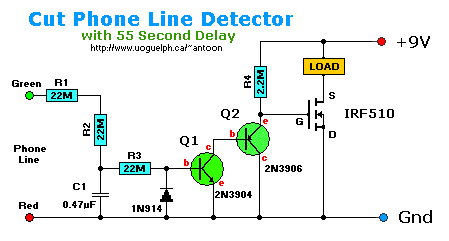
Parts List
R1,R2,R3 = 22M, Resistor
R4 = 2.2M, Resistor
C1 = 0.1uF to 0.47uF, 250V, Mylar, Capacitor
D1 = 1N914, NTE519, or other small signal diode (1N4148)
Q1 = 2N3904, NTE123AP, Transistor
Q2 = 2N3906, NTE159, Transistor
Q3 = IRF510, NTE2382, Power MosFet
Description:
This circuit speaks for
itself. When the phone line is okay, Q1 acts as a short with a very high ohms value via R1, R2, and R3 for a total of
about 66 MegOhm so very high. When the phone line is cut (open), it activates the MosFet (Q3) via transistor Q2 to
drive the load. Substitutes are fine, none of the components are critical.
The 'Red' and 'Green' wires of a telephone wire are *NOT* the positive and negative. They are the TIP and RING wires.
So, don't get confused why the red telephone wire is connected to ground (Gnd).
The 'LOAD' can be anything you like. A relay, motor, lamp, tape-recorder, stereo, security system, or whatever.
Keep in mind that Phone companies don't like to have anything 'directly' connected to their wires for obvious reasons,
so use this circuit at your own risk. If you like to play it save use an Opto-Isolator or something, which also will
keeps your phone company happy. They don't like anything hooked up to their wires directly.
[Comment from Ron Harrison via our Forum:]
I ran a simulation on the circuit. The only discharge path for C1 is through the base of Q1. The time until the gate
voltage on the MOSFET rises will be highly dependent on the betas of Q1 and Q2. In the simulation, it took about 55
seconds after the line was 'cut' until the MOSFET turned on. This could probably vary from 25 to 1000 seconds,
depending on the betas.
Perhaps you just need to be patient after someone cuts the line. Of course, in 55 seconds a vicious killer could
already be in your house and stabbing you while you sleep. (Tony: thanks for your comments Ron!)
Return to ..

